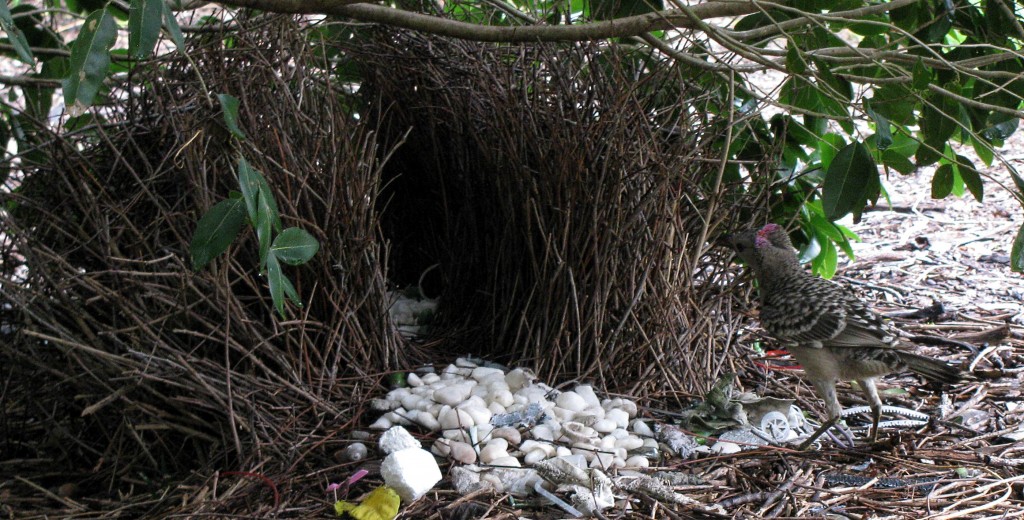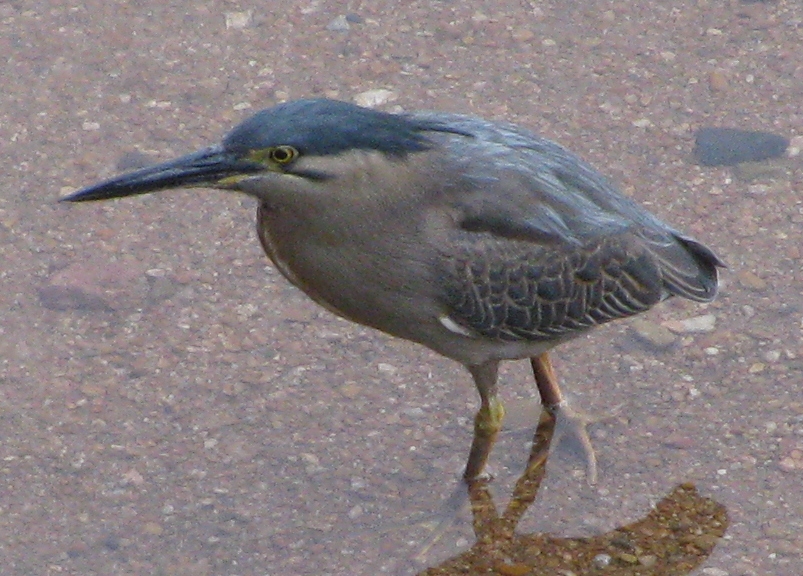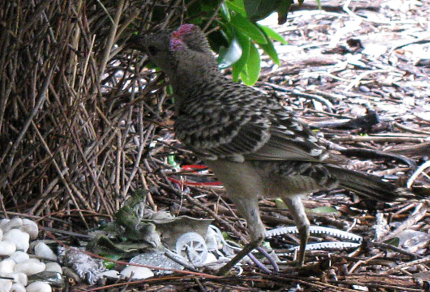
Male Great Bowerbird at Avenue Bower, Townsville (© Magi Nams)
Got him! This morning, while birding in Idalia, I photographed a male great bowerbird at his avenue bower. Surprisingly accommodating (considering how many times I’ve unsuccessfully attempted to photograph bowerbirds in the past eight months here in Australia), the male rearranged twigs in the walls of his bower, brought a new ornament for his collection, and fussed with the pile of stones, shells, and plastic bits spilling out of one end of the bower. Constantly active, he flared his pinkish-purple crest at times, scolded me incessantly, and frequently dashed into the avenue or flew up among the dense branches of the small tree overhanging the bower. On my arrival at the bower site, I’d noticed two bowerbirds at the bower, indicating that a female had come to inspect the male’s handiwork, or to mate within the bower. I snapped a dozen photographs, finishing with only two that aren’t blurry, the one above, and that below, which illustrates the male with his crest partially raised.

Male Great Bowerbird with Crest Partially Raised (© Magi Nams)
The bowerbird, with his brash, scratchy voice, wasn’t the only bird I encountered that was intent on courtship ritual.
A pair of petite leaden flycatchers bowed heads to each other and fluttered fanned tails. Dressed in a tuxedo-like plumage of black and white, the male, with black feathers at the back of his head raised in a crest, courted his chosen mate with low rasping utterances like those of a frog. “Weer-it, weer-it,” he repeated, while the female clad in grey, cinnamon, and white responded with clicking sounds that alternated neatly with the male’s vocalizations. Completely oblivious to me, the pair bobbed and curtsied to each other, their beaks almost touching, their tails fanning and fluttering in a manner that certainly captured my attention and presumably captivated theirs as well, with each other.
In some respects, my entire birding foray was a walk through a concert of avian lust and machismo in the form of the territorial songs sung by brown honeyeaters staking their claims to patches of trees and shrubs, and the songs of others – the yellow and white-gaped honeyeaters, the brush cuckoo, and so on. After eight months of familiarizing myself with Australian songbirds, I sometimes listen to these concerts as though they were lively conversations vocalized for my benefit, rather than the intense, energy-demanding breeding displays they truly are. Today, I’m reminded.

Striated Heron on Ross River Sandbar, Townsville (© Magi Nams)
Today’s birds: rainbow lorikeets, peaceful doves, magpie-larks, blue-faced honeyeaters, mynas, great bowerbirds, bush stone-curlews, house sparrows, brown honeyeaters, Australian white ibises, yellow-throated miners, helmeted friarbird, rock doves, masked lapwings, straw-necked ibises, Australian magpie, great egret, welcome swallows, striated heron, mistletoebird, sulphur-crested cockatoos, spangled drongos, leaden flycatchers, yellow honeyeaters, rainbow bee-eaters, white-gaped honeyeaters, laughing kookaburra, pheasant coucal, figbirds, crested pigeon, olive-backed oriole, blue-winged kookaburra, little pied cormorants, brush cuckoo, silver gulls, white-breasted woodswallow.


